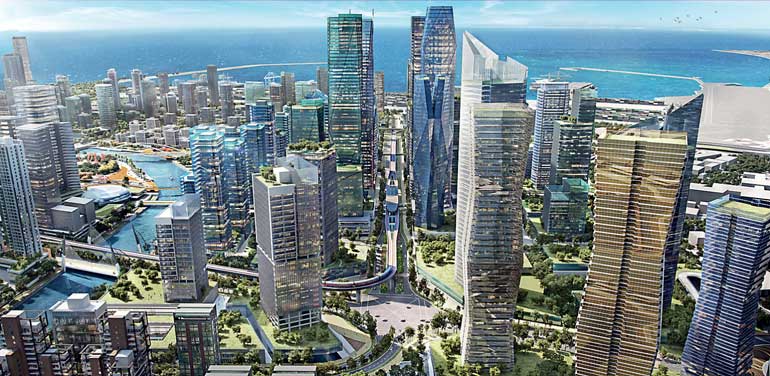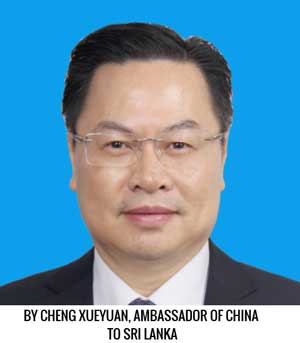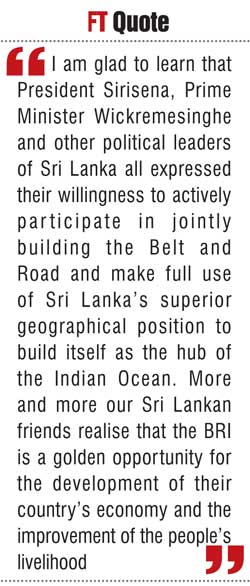Thursday Apr 24, 2025
Thursday Apr 24, 2025
Monday, 9 April 2018 00:00 - - {{hitsCtrl.values.hits}}

Port City Colombo

In January 2018 I arrived in Colombo and assumed office as the 21st Chinese Ambassador to Sri Lanka. During the last two months I widely contacted friends from all sectors, deepened my understanding of Sri Lanka and bilateral relations, and consolidated my confidence in the future of pragmatic China-Sri Lanka cooperation.
On the occasion of the Sinhala and Tamil New Year, I sincerely convey the best wishes, on behalf of the Chinese Embassy, to our Sri Lankan friends and would like to take this opportunity to share with you my opinions on our practical cooperation under the framework of the Belt and Road Initiative in order to better benefit our two countries and peoples.
I. The Belt and Road Initiative is China’s answer to the world’s economic difficulties and the path for building a community with a shared future for mankind
2018 marks the 40th anniversary of China’s reform and opening up. Over the past 40 years, China’s GDP has grown from $ 200 billion to $ 12.7 trillion, with an average annual growth of nearly 10%, and an increase of GDP per capita from less than $ 200 to $ 8,800. A population of 1.3 billion has generally achieved a well-off society level, which contributes more than 70% to global poverty reduction and more than 30% to global economic growth.
2018 also marks the 5th anniversary of the Belt and Road Initiative. This great initiative proposed by President Xi Jinping covers the vast continents and oceans of Asia-Europe-Africa and is expected to benefit more than 60% of the world’s population.
Over the past five years, more than 100 countries and international organisations have actively participated in BRI, among which more than 80 have signed the BRI cooperation agreement with China.
A large number of cooperation projects have already taken root. In May 2017, the first Belt and Road Forum for International Cooperation attracted the participation of more than 140 countries and international organisations, including Sri Lanka. BRI has been widely recognised and welcomed by the international community.
Tracing the source, reform and opening up, as well as BRI, both reflect the Communist Party of China being faithful to its original aspiration and continuing marching forward. CPC is a political party that not only seeks happiness for the Chinese people but also struggles for the cause of progress for all mankind. It is written in the party constitution.
On one hand, in order to realise the Chinese dream of national rejuvenation, CPC has persisted in deepening reform and opening up, pushed forward construction under the guidance of Xi Jinping Thought on Socialism with Chinese Characteristics for a New Era, and strived to achieve the “Two Centenary Goals”, which means “by 2021, the CPC’s centenary, the goal is to build a moderately prosperous society in all respects; by 2049, the centenary of the People’s Republic of China, the goal is to build China into a great modern socialist country that is prosperous, strong, democratic, culturally advanced, harmonious and beautiful.”
On the other hand, while achieving its own development, the Chinese Government and the CPC have never forgotten the historic mission of safeguarding world peace and promoting common development.
President Xi Jinping reaffirmed that China will persevere in the path of peaceful development, forging a new form of international relations featuring mutual respect, fairness, justice and win-win cooperation, building a community with a shared future for mankind, for which the Belt and Road Initiative has been raised as an important practice path. It reflects the ruling party and the Government’s determination and responsibility.
China’s development cannot be isolated from the world, while the development of the world also needs China. Today’s world shows a lack of motivation in economic growth, full of turbulence in certain areas and full of unbalance in regional development. Some global or regional powers often shift their own problems to other smaller countries in order to maintain their own interests, which have triggered the alarm of unilateralism and anti-globalisation.
The proposal of BRI comes at the right time and the Chinese voice has become the strongest support for multilateralism and globalisation. BRI conforms to the trend of the 21st century in peace, development, cooperation and win-win cooperation, provides an all-inclusive development platform for almost all countries around the world.

II. The Belt and Road Initiative is highly compatible with Sri Lanka’s national development strategy
Sri Lanka has been an important stop on the Maritime Silk Road ever since ancient times. The friendly relations between China and Sri Lanka have always been based on mutual respect and support.
About 1,600 years ago, Master Fa Xian returned to China from Sri Lanka via the Maritime Silk Road to proclaim Buddhism, peace and friendship. About 600 years ago, the Zheng He Fleet visited Sri Lanka five times and brought bilateral economic and cultural exchanges to a new height. About 60 years ago, the two countries broke through the blockade of imperialism and signed the famous Rubber-Rice Pact, which once again connected the two peoples across the ocean. In recent years, China and Sri Lanka have also firmly supported each other in fighting terrorism, safeguarding national independence, sovereignty and territorial integrity.
It is unfortunate that the three-decade civil war severely restricted the island nation’s economic and social development. After finally bringing an end to the war in 2009, Sri Lanka was facing an important and rare opportunity to develop itself upon the war ruins, and urgently expecting the international community to provide strong support in infrastructure construction and financial investment, etc.
However, because of the international financial crisis and some ideological reasons, Sri Lanka did not receive the expected foreign support. At this critical moment, it was China again that stood up with open hands and participated in the reconstruction in all directions. Logically, Sri Lanka became one of the first countries to openly support the Belt and Road Initiative since it was highly compatible with Sri Lanka’s national development strategy.
I am glad to learn that President Sirisena, Prime Minister Wickremesinghe and other political leaders of Sri Lanka all expressed their willingness to actively participate in jointly building the Belt and Road and make full use of Sri Lanka’s superior geographical position to build itself as the hub of the Indian Ocean. More and more our Sri Lankan friends realise that the BRI is a golden opportunity for the development of their country’s economy and the improvement of the people’s livelihood.
In the past five years the two countries have made significant progress in jointly building the Belt and Road in Sri Lanka. The completion of the Norocholai Power Station (or the Puttalam Power Station) provided about 40% of the nation’s electricity supply and ended the history of frequent power cuts on the island. The Katunayake Expressway (Colombo airport expressway) has brought great convenience to international travellers and contributed to the blossoming of tourism. The Colombo International Container Terminal, a Sino-SL joint venture, becomes the fastest growing container terminal in the world. The newly completed Moragahakanda Project, which is the biggest reservoir in Sri Lanka, has brought great benefits to local agriculture and people.
In October this year, Section-I of the Southern Railway, the first railway to be built in the past 100 years, will be officially opened. By the end of next year, the expressway linking Colombo and Hambantota will also be connected.
As of the end of 2017, Chinese companies have completed more than $ 15 billion in infrastructure projects in Sri Lanka such as those involving transportation, water, electricity, ports and other fields, and have made great contributions to the economic and social development of this country.
In addition, our pragmatic cooperation has also created more than 100,000 jobs for Sri Lanka and trained tens of thousands of technical and management personnel. Take the CICT as an example. It employs more than 1,000 local technical staff, accounting for 90% of its total employees. Such cooperation laid a solid foundation for Sri Lanka to further its own development.
III. Colombo Port City together with Hambantota Port and Industrial Zone will boost Sri Lanka’s fast development
China and Sri Lanka have strong complementarities and the potential for cooperation is still far from being released. Sri Lanka is located at the centre point of the main international waterway of the Indian Ocean, which brings the biggest advantage for its development. Therefore, the construction and operation of sea ports, especially Colombo and Hambantota, become key issues to be taken seriously.
According to my knowledge, Colombo Port City together with the Hambantota Port and the Industrial Zone are like two powerful engines for the Sri Lankan economy to take off. With the continuous development of these mega projects, Sino-SL economic and trade cooperation is expected to start a new chapter.
The Colombo Port City is jointly developed by a Chinese company and the Sri Lanka Port Authority, aiming to build a shipping, logistics, tourism and financial centre in South Asia, with a direct investment of $ 1.4 billion and a planned second level building complex of $ 13 billion.
It is expected that more than 80,000 jobs will be created. At present, 80% of the land reclamation projects have been completed and the investment promotion of the CIFC building complex is also proceeding smoothly.
The Port City has already attracted the great attention of a large number of investors from China, the US and Europe, etc. With the blue waters and pink sunset of the Indian Ocean, the port city site under construction offers the most spectacular and beautiful scenery in Colombo.
With its excellent location, Hambantota will play an important role in the development of the southern region of Sri Lanka. To facilitate it, China has undertaken the construction of the Hambantota Port at the request of the Sri Lankan Government.
The Government tried to turn to some foreign countries for port operating but failed and the port operations were greatly affected. To solve this problem, at the end of 2017, Chinese companies were again invited by the Sri Lanka side to join hands with the Sri Lanka Port Authority and obtained the right to operate the port together, respectively accounting for 70% and 30% of the shares. The whole procedure was in accordance with international rules, laws and market practices, and done in a fully open, equal and transparent way.
Three months since then, the entire port is now developing fast with constant change. The ro-ro shipping business has increased significantly and the shipping supply business is rapidly recovering.
In addition, both sides have also agreed to establish an industrial park in Hambantota, to fully explore the huge advantages of the port. At present, the negotiations of large-scale projects such as LNG power stations, petroleum refinery, cement, iron and steel manufacture are accelerating, which are expected to bring drastic changes to the local economy and people’s livelihood and surely become another new engine for Sri Lanka’s development.
IV. China in the new era expects closer collaboration with Sri Lanka
The Belt and Road is a transparent initiative and a global public goods. From the very beginning, it follows the golden rule of extensive consultation, joint contribution and shared benefits, abides by international rules and follows market principles.
Just as the State Councilor and Foreign Minister Wang Yi mentioned, the planning and implementation of BRI projects have been discussed by the participants in the open.
No country is dominating the process; all parties have an equal say. There is no back-room deal; everything is transparent. There is no ‘winner takes all’ attitude, every project delivers win-win results.
Promoting BRI needs to abandon the Cold War thinking and zero-sum game concept. The real reason why the Belt and Road is widely supported lies in its clear equality, openness and inclusiveness.
I would like to quote a Chinese poem written almost one thousand years ago: “I have no fear that floating clouds may blur my eyes, for on the topmost storey of the building am I.”
We’re fully confident that as the Belt and Road cooperation continues to develop along the right track, as we continue to climb upwards, those blinding and irrational criticism on BRI will eventually disappear like floating clouds.
As socialism with Chinese characteristics enters a new era, China’s reforms will become deeper and deeper, its opening up will grow bigger and bigger, and Belt and Road cooperation will be stronger and stronger. With the biggest population and the second largest economy in the world, being the second largest importer and consumer, China will import more than $ 10 trillion in goods and services, invest more than $ 750 billion abroad in the next five years and the number of outbound tourists will exceed 700 million.
The development of China is just like a fast-moving train with a clear destination and bright future. The Chinese people, with open arms, welcome all countries, including Sri Lanka, to take the train and share common development. We sincerely expect all sectors in Sri Lanka to join hands with us to jointly build the Belt and Road and a Sino-Sri Lanka destiny community, to jointly create a beautiful and bright future for our two peoples.
Discover Kapruka, the leading online shopping platform in Sri Lanka, where you can conveniently send Gifts and Flowers to your loved ones for any event including Valentine ’s Day. Explore a wide range of popular Shopping Categories on Kapruka, including Toys, Groceries, Electronics, Birthday Cakes, Fruits, Chocolates, Flower Bouquets, Clothing, Watches, Lingerie, Gift Sets and Jewellery. Also if you’re interested in selling with Kapruka, Partner Central by Kapruka is the best solution to start with. Moreover, through Kapruka Global Shop, you can also enjoy the convenience of purchasing products from renowned platforms like Amazon and eBay and have them delivered to Sri Lanka.
Discover Kapruka, the leading online shopping platform in Sri Lanka, where you can conveniently send Gifts and Flowers to your loved ones for any event including Valentine ’s Day. Explore a wide range of popular Shopping Categories on Kapruka, including Toys, Groceries, Electronics, Birthday Cakes, Fruits, Chocolates, Flower Bouquets, Clothing, Watches, Lingerie, Gift Sets and Jewellery. Also if you’re interested in selling with Kapruka, Partner Central by Kapruka is the best solution to start with. Moreover, through Kapruka Global Shop, you can also enjoy the convenience of purchasing products from renowned platforms like Amazon and eBay and have them delivered to Sri Lanka.